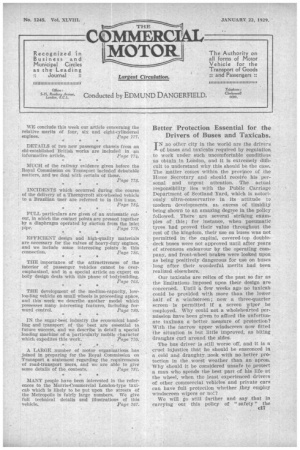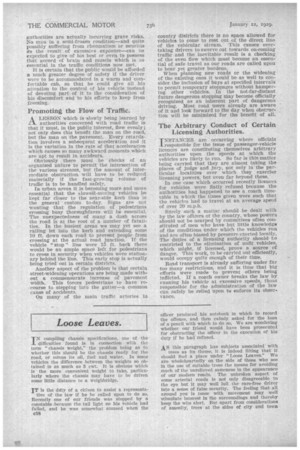Better Protection Essential for the Drivers of Buses and Taxicabs.
Page 1

Page 2

If you've noticed an error in this article please click here to report it so we can fix it.
TN no other city in the world are the drivers -Iof buses and taxicabs required by regulation to work under such uncomfortable conditions as obtain in London, and it is extremely difficult to understand why this should be the case. The matter comes within the province of the Home Secretary and should receiie his personal and urgent attention. The actual responsibility lies with the Public Carriage Department of Scotland Yard, which is notoriously ultra-conservative in its attitude to modern developments, an excess of timidity , being, shown to an amazing degree in the policy followed. Thereare several striking examples of this; for instance, when pneumatic tyres had proved their value throughout the vest of the kingdom, their use on buses was not permitted in the capital, covered-top doubledeck buses were not approved until after years of strenuous endeavour by the operating company, and front-wheel brakes were looked upon as being positively dangerous for use on [Rises • long after. their • wonderful merits had been realized elsewhere.
Our taxicabs are relics of the past so far as the .limitations imposed upon their design are concerned. Until a" few weeks ago no taxicab could • be provided with more than the lower half of a windscrden; now a three-quarter screen is permitted if a screen wiper be employed. Why could not a wholehearted permission have been given to afford the unfortunate taximan a better measure of protection? With the narrow upper windscreen now fitted the situation is but little improved; as biting draughts curl around the sides.
The bus driver is still worse off, and it is a cruel injustice that he should he ensconced in a cold and draughty, nook with no better protection in the worst weather than an apron. Why should it be considered unsafe to protect a man who spends the hest part of his life at the wheel, when the least experienced drivers of other commercial vehicles' and private cars can have full protection whether they employ windscreen wipers or not?
We will go still farther and say that in carrying out this policy of "safety " the authorities are actually incurring grave risks. No mau in a semi-frozen condition—and quite possibly suffering from rheumatism or neuritis rts the result of excessive exposure—can be expected te give of his best or even to possess that accord of brain and muscle which is so essential in the traffic conditions now met.
It is certain that the public would be afforded a much greater degree of safety if the driver were to be accommodated in a warm and comfortable cab, so that he could give all his attention to the control of his vehicle instead of devoting part of it to the consideration of his discomfort and to his efforts to keep from freezing.
Promoting the Flow of Traffic.
ALESSON which is slowly being learned by authorities concerned with road traffic is that it must, in the public interest, flow evenly ; not only does this benefit the man on the road, but the man on the pavement. Every retardation involves a subsequent acceleration and it is the variation in the rate of that acceleration which causes so many awkward moments which are apt to result in accidents.
Obviously there must be checks of an organized nature to permit the intersection of the various streams, but the amount of intermediate obstruction will have to be reduced materially if the fast-growing volume of traffic is to be handled safely.
In urban areas it is becoming more and more essential that the slowest-moving vehicles be kept far closer to the near-side kerb than is the general custom to-day. Signs are not wanting that the regulation of pedestrians crossing busy thoroughfares will be essential. The unexpectedness of many a dash across the road is at the root of a number of fatalities. In the busiest areas we may yet see a railing let into the kerb and extending some 10 ft. down each road to prevent people from crossing at the actual road junction. If the 'vehicle " stop " line were 15 ft. back there would be an ample space left for pedestrians to cross in security when vehicles were stationary behind the line. This early stop is actually being tried out in certain districts.
Another aspect of the problem is that certain street-widening operations are being made without a commensurate increase of pavement width. This forces pedestrians to have recourse to stepping into the gutter—a common cause of accidents.
On many of the main traffic arteries in country districts there is no space allowed for vehicles to come to rest out of the direct line of the vehicular stream. This causes overtaking drivers to swerve out towards on-coming traffic and the inevitable result is a chedking of the even flow which must become an essential of safe travel as our roads are called upon to bear yet greater burdens.
When planning new roads or the widening of the existing ones it would be as well to consider the inclusion of bays at specified intervals to permit temporary stoppages without hampering other vehicles. In the not-far-distant future dangerous stopping May become officially recognized as an inherent part of dangerous driving. Most road users already are aware of it and look forward to the day when obstruction will be minimized for the benefit of all.
The Arbitrary Conduct of Certain.
Licensing Authorities. .
TNSTANCES are occurring where officials _Lresponsible for the issue of passenger-vehicle licences are constituting themselves arbitrary authorities upon the speeds at which the vehicles are likely to run. So far is this matter' being carried that they are almost taking the places of judge and jury, not only in the particular localities over which they exercise licensing powers, but even far beyond these.'
In one case which occurred recently licences for vehicles were flatly refused because the authorities had happened to see a coach timetable in which the times given were such that the vehicles had to travel at an average speed of over 20 m.p.h.
&hely such a matter should be dealt with by the law officers of the country, whose powers should not be usurped by committees often constituted of men who have but little knowledge of the conditions under which the vehicles run and are often biased by pressure exerted locally. The duties of a licensing authority shouldbe restricted to the elimination of unfit vehicles, which might, if licensed, prove a source of danger. This work, to be carried out efficiently, would occupy quite enough of their time.
Road transport is already suffering under far too Many restrictions, and it is time that big efforts were made to prevent others being inflicted. If a coach owner breaks the law by running his Vehicle at excessive speeds, those responsible for the administration of the law can safely be relied upon to enforce its observance.


































